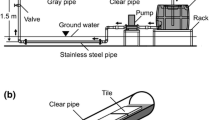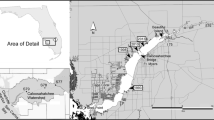Abstract
A long-term experiment was conducted to compare the effects of flowing and still water on growth, and the relationship between water flow and nutrients, in Aponogeton elongatus, a submerged aquatic macrophyte. A. elongatus plants were grown for 23 weeks with three levels of nutrition (0, 0.5 and 1g Osmocote Plus® fertiliser pot−1) in aquaria containing stirred or unstirred water. Fertilized plants grew much better than non-fertilized. The highest fertilizer level produced 29% wider leaves and 58% higher total dry weight in stirred water. Stirred water increased leaf area by 40% and tuber size by 81%, but only with the highest level of nutrition. These results suggest that this plant depends on its roots for mineral uptake, rather than from the open water, and the major limitation to growth in still water is the supply of dissolved inorganic carbon. It was the combined effects of nutrient availability and stirring that produced the strongest response in plant growth, morphology and composition. This study provides some explanation for the observations of others that these plants grow best in creeks or river systems with permanently flowing water.
Similar content being viewed by others
References
Allen, E. D. & D. H. N. Spence, 1981. The differential ability of aquatic plants to utilise the inorganic carbon supply in fresh waters. New Phytol. 87: 269–283.
Aston, H. I., 1973. Aquatic Plants of Australia. University Press, Melbourne.
Barko, J. W., R. M. Smart, D. G. McFarland & R. L. Chen, 1988. Interrelationships between the growth of Hydrilla verticillata (L.f.) Royle and sediment nutrient availability. Aquat. Bot. 32: 205–216.
Best, E. P. H., H. Woltman & F. H. Jacobs, 1996. Sedimentrelated growth limitation of Elodea nuttallii as indicated by a fertilisation experiment. Freshwat. Biol. 36: 33–44.
Bowes, G. & M. E. Salvucci, 1989. Plasticity in the photosynthesis carbon metabolism of submersed aquatic macrophytes. Aquat. Bot. 34: 233–266.
Bristow, J. M. & M. Whitcombe, 1971. The role of roots in the nutrition of aquatic vascular plants. Am. J. Bot. 58, 8–13.
Carpenter, R. C., J. M. Hackney & W. H. Adey, 1991. Measurements of primary productivity and nitrogenase activity of coral reef algae in a chamber incorporating oscillatory flow. Limnol. Oceanogr. 36: 40–49.
Chambers, P. A., E. E. Prepas, H. R. Hamilton & M. L. Bothwell, 1991. Current velocity and its effect on aquatic macrophytes in flowing water. Ecol. Appl. 1: 249–257.
Frith, M., N. Forteath & L. Wee, 1993. Appendix II. Chemical determination of selected water quality parameters. In Hart P. & D. O'sullivan (eds), Aquaculture Source Book: Recirculation Systems, Design and Management. Turtle Press, Launceston, Tasmania: pp 111–127.
Hellquist, C. B. & S. W. L. Jacobs, 1998. Aponogetonaceae of Australia, with descriptions of six new taxa. Telopea 8(1): 7–19.
Islam, Q. R., 1996. Morphology and nutritional value of Aponogeton undulatus Roxb. growing in deeply flooded areas in Bangladesh. Hydrobiologia 340: 317–321.
Jahnke, L. S., T. T. Eighmy & W. R. Fagerberg, 1991. Studies of Elodea nuttallii grown under photorespiratory conditions: I. Photosynthetic characteristics. Plant Cell Environ. 14: 147–156.
Kirk, J. T. O., 1994. Light and Photosynthesis in aquatic ecosystems, 2nd edn. Cambridge University Press, Cambridge: 509 pp.
Larkum, A. W. D., G. Roberts, J. Kuo & S. Strother, 1989. Gaseous movement in seagrasses. In Larkum A. W. D., A. J. McComb & S. A. Shepherd (eds), Biology of Seagrasses. Aquatic Plant Studies. Elsevier, Amsterdam, N. Y.: 686–722.
Losse, R. F. & R. G. Wetzel, 1993. Littoral flow rates within and around submerged macrophyte communities. Freshwat. Biol. 29: 7–17.
Madsen, T. V., H. O. Enevoldsen & T. B. Jorgensen, 1993. Effects of water velocity on photosynthesis and dark respiration in submerged stream macrophytes. Plant Cell Environ. 16: 317–322.
Miller, A. G. & B. Colman, 1980. Evidence of HCO3 transport by the blue green alga (Cyanobacterium) Coccochloris peniocystis. Plant Physiol. 65: 397–402.
Rattray, M. R., C. Howard-Williams & J. M. A. Brown, 1991. Sediment and water as sources of nitrogen and phosphorus for submerged rooted aquatic macrophytes. Aquat. Bot. 40: 225–238.
Robach, F., I. Hajnsek, I. Eglin & M. Tremolieres, 1995. Phosphorus sources for aquatic macrophytes in running waters: water or sediment? Acta Bot. Gallica. 142: 719–731.
Sainty, G. R. & S. W. L. Jacobs, 1981. Water Plants of New South Wales.Water Resources Commission, New SouthWales: 550 pp.
Sainty, G. R. & S. W. L. Jacobs, 1994. Water Plants of Australia: A Field Guide. Sainty and Associates, Darlinghurst: 327 pp.
Salisbury, F. B. & C. W. Ross, 1992. Plant physiology. Wadsworth Publishing Co., Belmont, California: 682 pp.
Sand-Jensen, K., 1983. Photosynthetic carbon sources of stream macrophytes Callitriche stagnatis, Potamogeton crispus, Potamogeton pedenatus, Sparganium simplex. J. exp. Bot. 34(139): 198–210.
Schwenke, H., 1971. Water Movement. In Kinne, O. (ed.), Marine Ecology, A Comprehensive, Integrated Treatise on Life in Oceans and Coastal Waters, Environmental Factors, Part 2. Wiley-Interscience, a division of John Wiley and Sons Ltd, London, Vol. 1: 1091–1121.
Sculthorpe, D. C., 1967. The Biology of Aquatic Vascular Plants. London, Edward Arnold (Publishers) Ltd. London: 610 pp.
Smith, F. A. & N. A. Walker, 1980. Photosynthesis by aquatic plants: effects of unstirred layers in relation to assimilation of CO2 and HCO?3 and to carbon isotopic discrimination. New Phytol. 86: 245–259.
Spence, D. H. N., 1976. Light and plant response in fresh water. In Evans, G.C., R. Bainbridge & O. Rackham (eds), Light as an Ecological Factor: II. Oxford, Blackwell Sci. Publ.: 93–133.
Stevens, C. L. & C. L. Hurd, 1997. Boundary-layers around bladed aquatic macrophytes. Hydrobiologia. 346: 119–128.
Stumm, W. & J. J. Morgan, 1970. Aquatic Chemistry: an Introduction Emphasising Chemical Equilibria in Natural Waters. Wiley-Interscience, N Y.
Titus, J. E., R. S. Feldman & D. Grise, 1990. Submersed macrophyte growth at low pH. I. CO2 enrichment effects with fertile sediment. Oecologia 84: 307–313.
Van-Bruggen, H. W. E., 1969. Revision of the genus Aponogeton (Aponogetonaceae) III. The species of Australia. Blumea 17: 122–133.
Wigand, C. & C. J. Stevenson, 1997. Facilitation of phosphate assimilation by aquatic mycorrhizae of Vallisneria americana Michx. Hydrobiolohis. 342/343: 35–41.
Author information
Authors and Affiliations
Rights and permissions
About this article
Cite this article
Crossley, M.N., Dennison, W.C., Williams, R.R. et al. The interaction of water flow and nutrients on aquatic plant growth. Hydrobiologia 489, 63–70 (2002). https://doi.org/10.1023/A:1023298302557
Issue Date:
DOI: https://doi.org/10.1023/A:1023298302557




